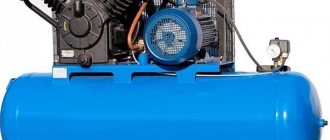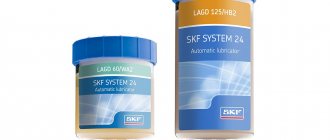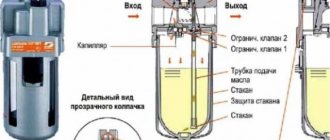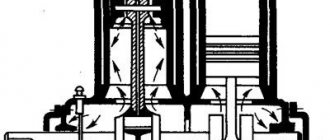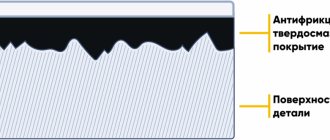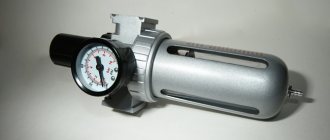Original German autobuffers Power Guard
Mirror-video recorder FUGICAR FC8
Sun blinds Trokot with magnets!!!
Compressor oil is a special type of fuel and lubricant, specially designed for use in moving components and assemblies of compressor equipment. There are several types of compressor oils, each having its own area of application and differing in operational and technical characteristics.
Description and features
In terms of their area of use and technical characteristics, compressor oils are classified as motor oils. They are operated under similar conditions - they are exposed to elevated temperatures and sudden changes in operating conditions.
Like other oils used to lubricate internal combustion engines, compressor lubricants are created on a mineral, synthetic or semi-synthetic basis.
The cost of fuels and lubricants depends on this - synthetics, which are more durable and have better performance properties, will accordingly cost the buyer more.
Another important technical indicator is the degree of viscosity, which determines the fluidity of the oil. The higher this indicator, the more easily the lubricant penetrates into the smallest gaps of moving parts inside the mechanism. The low viscosity coefficient of the oil facilitates the operation of the compressor unit, reducing friction and preventing the formation of harmful deposits in the gaps - soot, corrosion and oxides.
The peculiarity of using lubricants for compressors lies in their technical design.
The compressor operates like a conventional internal combustion engine, but in reverse mode. If in an internal combustion engine the torque from the piston group is transmitted to the crankshaft via the connecting rod shaft, then in compressors it is the other way around - from the crankshaft the torque goes to the piston group, which pumps air into the receiver or supplies it directly to the consumer. In the case of a car engine, oil that gets into the piston chamber will simply burn along with the fuel.
In a compressor, the lubricant that gets into the piston group will inevitably end up in the receiver chamber or in the environment into which the compressed air is supplied. Such contamination by fuel particles can lead to negative consequences, therefore special technical requirements are imposed on compressor oils.
Characteristics that determine which oil can be poured into the compressor
It is the discharge temperature that is one of the main parameters (relating to the safety of the compressor).
- category 1 – gentle operating conditions, up to 160°C;
- category 2 – standard operating conditions, up to 180°C;
- category 3 – heavy duty for continuous operation of compressor stations, up to 200°C;
- category 4 – harsh working conditions, including in aggressive environments, over 200°C.
A number of other parameters depend on the lubrication method used in specific compressor models. This list is determined by the equipment manufacturer.
- Oil is supplied under pressure using nozzles. This is an entire system that has a separate capacity (replenishment and replacement are carried out directly during operation). Viscosity is selected in strict accordance with operating conditions, including ambient temperature.
- Discharge using an internal gear pump also requires low viscosity, but is not dependent on the degree of oil heating.
- Natural splashing from the crankcase oil bath does not require special characteristics; standard values for transformer oils are sufficient.
As an example, an illustration of the parameters of Lukoil KS-19 motor oil.
Basic requirements for the characteristics of compressor oil
Due to the fact that compressor lubricants must be separated from the gases pumped into the cylinders, volatility is an important parameter. This characteristic is measured when the liquid is heated to operating temperature, which occurs after 10-15 minutes of operation of the unit. Characteristics of Ravenol compressor oil - video
- When creating oils, manufacturers are forced to compromise. On the one hand, a minimum viscosity is required, on the other hand, oil that is too thin is prone to evaporation. Therefore, binders must be added to the composition.
- Another requirement that compressor manufacturers make is a low oxidation coefficient. With prolonged use, the oil may burn. Soot and soot are formed, which gets on the cylinder walls and leads to the formation of scratches and scoring.
- The degree of wear resistance characterizes the ability to maintain specified characteristics until the oil is changed. If the parameters gradually decrease, it is impossible to ensure stable operation of the compressor.
- After short-term heating to a critical temperature, the basic indicators should return to their original state.
- Additives must be added to prevent foaming. The crank mechanism works like a mixer. The oil will simply whip up in the crankcase without creating a strong working film.
The complex of properties of compressor oil, from any manufacturer, must ensure:
- reliable start-up of equipment regardless of external temperature;
- if possible, reduce energy costs for operating units;
- at high loads on the piston group, there should be no prerequisites for jamming of the rubbing pairs;
- prevention of emulsion formation: with a sharp change in pressure in the piston group, condensate forms, which must be bound by demulsifiers.
Composition and performance characteristics
To ensure trouble-free operation and long service life of the mechanisms, the lubricant must meet the following requirements:
- Ensure temperature stability by effectively cooling the moving internal components of the compressor;
- Prevent the formation of coke-like deposits during oil heating;
- Have a stable viscosity indicator over a wide range of operating temperatures;
- Maintain the tightness of the joints of the parts, filling all the gaps;
- It is good to lubricate rubbing parts to avoid abrasion and overheating.
To achieve the above requirements, compressor oils have the following performance and technical characteristics:
- The viscosity coefficient at t = 100ºC varies in the range from 7 to 30 centistokes;
- Low degree of evaporation, including at elevated operating temperatures;
- Ability to perform its functions at high temperatures of mechanism components and pumped substances. According to the requirements of technical standards, the ignition temperature of compressor lubricant should be from 190 to 270ºC;
- Chemical neutrality. It must not react with the pumped gases. When used in refrigeration units, compressor oil must be inert towards refrigerants.
Based on their composition, compressor oils are divided into mineral-based varieties. These are either pure mineral oils or have a certain percentage of additives that provide anti-corrosion properties, oxidative stability, and increase the service life of fuels and lubricants.
In recent years, synthetic and semi-synthetic oils made from hydrotreated or essential oils have become widespread. Their main advantage compared to mineral oil is their improved technical characteristics. This concerns the fluidity rate, the lower solidification threshold, and the ability to work for a long time in particularly difficult conditions.
What kind of oil should I put in the compressor? Differences between compressor and engine oil.
What kind of oil can be poured into the compressor is indicated in its passport. An analogue can be selected using a special table, for example:
| Russian brand | Imported analogue | ||||||||
| Gazpromneft | Castrol | Mobile | Fuchs | Shell | Total | Ravenol | Teboil | Texaco | |
| Gazpromneft Compressor VDL-46 | Aircol pd 46 | Mobil Rarus 425 | No analogue | Corena D 46 | DACNIS VS 46 | Kompressorenoel VDL 46 | Compressor Oil P 46 | COMPRESSOR OIL EP VD-L 46 | |
| Gazpromneft Compressor VDL-68 | Aircol pd 68 | Mobil Rarus 426 | RENOLIN 500 ISO VG 68 | Corena D 68 | DACNIS VS 68 | Kompressorenoel VDL 68 | Compressor Oil P 68 | COMPRESSOR OIL EP VD-L 68 | |
| Gazpromneft Compressor VDL-100 | Aircol pd 100 | Mobile Rarus 427 | RENOLIN 500 ISO VG 100 | Corena P 100 | DACNIS P 100 | Kompressorenoel VDL 100 | Compressor Oil P 100 | COMPRESSOR OIL EP VD-L 100 | |
| Gazpromneft Compressor VDL-150 | Aircol pd 150 | Mobile Rarus 429 | RENOLIN 500 ISO VG 150 | Corena P 150 | DACNIS P 150 | Kompressorenoel VDL 150 | No analogue | COMPRESSOR OIL EP VD-L 150 | |
| Gazpromneft Compressor VDL-220 | No analogue | No analogue | No analogue | No analogue | DACNIC P 220 CD | No analogue | No analogue | No analogue | |
For high-pressure compressor units, synthetics are best suited (the choice is made based on viscosity and flash point).
Before pouring new oil into the compressor, it is necessary to drain the old one, clean pneumatic and oil hoses, coolers, separators, valves from its residues, and change filters.
It is not advisable to use motor or diesel oil for piston compressors, but it is acceptable; only special oil is poured into screw compressors. However, pouring motor oil into an air compressor can be dangerous - at the same flash point as compressor oil, it has a lower flash point.
When deciding which oil to pour into the compressor when refueling, keep in mind: when mixing alloyed mineral water, semi-synthetics and synthetics from different manufacturers, the additives may turn out to be incompatible and precipitate.
Features of choosing a lubricant for an air piston compressor
Compressor oil for piston compressors comes into contact with hot air, and therefore must have high resistance to thermal oxidation and an ignition temperature of at least +350°C. Viscosity grades – 100, 150 according to ISO.
The main technical characteristics of domestically produced oil (viscosity) can be easily determined by the labeling. The designation of lubricants in this category looks like this: K-12, KS-19, K4-20, etc.
The letter K means that this product belongs to compressor lubricants, the number following it is the group according to operating conditions (the first group does not have a number). The number after the hyphen is the kinematic viscosity in mm2/s at t +100 ˚С. The letter C indicates that the material is produced from sour crude oil, P indicates the presence of additives.
In order to save money, industrial oil can be poured into the movement mechanism of compressor devices with a separate lubrication system.
If you use a lubricant with a viscosity higher than recommended for a compressor with an electric motor, problems with starting it may occur due to voltage fluctuations in the network.
When operating an air piston compressor year-round in outdoor conditions, it is advisable to replace mineral water with synthetic water (filled only after thorough flushing of the oil system and replacement of filters).
What oil to fill in a screw compressor
Oil for screw compressors must be resistant to aging, have a viscosity of at least 7 cSt (46, 48 ISO class), improved cooling, washing, anti-corrosion, anti-wear, anti-foaming and demulsifying properties, an ignition temperature above +180°C.
What kind of compressor oil to pour into a screw compressor directly depends on the operating conditions: in the warm season and in heated rooms, mineral water is quite suitable, while synthetics are ideal for all-season work in the open air.
Classification of compressor oils and their scope
All modern compressors are divided into two main types, differing in their design and operating features. These include:
- Volumetric. In such equipment, the distilled gaseous substance is sucked into the working chamber, compressed and thrown out under pressure by the forward-return movement of the piston system;
- Dynamic. The compression of the medium they distill is carried out using turbine mechanisms. The intake gas is accelerated by the turbine rotors, after which it suddenly slows down, causing it to be dynamically compressed.
In volumetric piston compressors, oil provides lubrication of moving parts - piston group, valves, bearings. Traditionally, such models use mineral oil that meets international certificates DIN-51506-VGL, VDL. The viscosity class for them corresponds to ISO/VG standards from 68 to 150. In positive displacement rotary or screw compressors, the moving parts are lubricated using an oil bath. As a result, the oil is constantly mixed with the forced air, heating to a temperature of about 90-100ºC.
At the outlet of the compressor chamber, a filter device is installed that separates the oil from the gaseous substance. Therefore, for use in rotary and screw compressors, oils with increased deaeration and demulsification characteristics are used.
Special requirements are also imposed on increased anti-corrosion properties and the maximum amount of deposits during operation. Most manufacturers of such equipment provide instructions in the accompanying instructions regarding the selection of a suitable lubricant.
In dynamic modifications of compressor units, lubrication is provided through a forced supply circuit: gears, shaft seals, bearings. It is recommended to use the same type of oil for the compressor operating mechanism and its drive system. It is recommended to use special turbine oils of the following grades in dynamic installations that comply with the ISO/DP-6521 standard:
- DIN-51-515 TDL-32;
- TDL-46;
- TDL-68;
- TDL-EP with extreme pressure additives.
Conventional motor oils are classified according to their flash point.
Compressor lubricants are divided, unlike motor lubricants, according to the temperature of the pumped substance.
In Russia, along with the international classification of compressor oils, the domestic classification adopted by Gostekhnadzor back in Soviet times is still often used.
According to it, all compressor oils are divided into 4 groups:
- Lubricant intended for operation under moderate loads. The temperature of the discharge gas does not exceed 160ºC.
- The second group is intended for operation under moderate loads, but with a discharge gas temperature of up to 180 degrees.
- Compressor lubricant of the third group is designed for mechanisms operating under increased loads and temperatures up to 200ºC.
- The last group includes oils intended for operation in extremely difficult conditions, with increased pressure and temperatures up to 200ºC.
Each group has a special list of operational and technical properties that must be taken into account when choosing the type of oil for the compressor.
It should be noted that foreign manufacturers have not developed a unified classification for operating temperature, and each large company uses its own standards.
Oil for air piston compressor
Oil in a piston compressor is the main consumable. It is designed to solve the following problems:
- lubrication of moving parts, reduction of friction;
- cooling of piston group parts;
- anti-detonation;
- additional sealing of working chambers.
If a decrease in tightness only reduces the performance of the unit, then insufficient lubrication or overheating can lead to failure of the unit, costly repairs, or even an accident. Therefore, the owner is obliged to monitor the level and replenish its supply as it is consumed.
Instructions for use
In order for compressor oil to provide effective protection of the mechanism, you must follow the main rules for its use:
- To select the correct class and type of oil, you must carefully read the technical instructions before filling. Manufacturers of compressor equipment always indicate the recommended lubricant in the specification;
- When filling, half of the required volume of lubricant is poured directly into the compressor mechanism, and the second half into the oil tank (receiver). In this case, the oil will be evenly distributed throughout the entire volume of the mechanism, ensuring the most complete filling of the gaps between the rubbing parts;
- When starting a compressor with freshly filled oil, there is a high probability of water hammer occurring, which can damage internal components and parts of the equipment. To avoid this problem, it is necessary to rotate the shaft manually several times to evenly distribute the lubricant;
- After filling, do not immediately turn on the compressor. It is necessary to wait about an hour, allowing the compressor oil to settle and fill all internal gaps;
- The oil must be changed in accordance with the manufacturer's technical recommendations, after a certain number of operating hours. If the operating hours during operation of the compressor are not calculated, then the optimal option would be the oil change range - twice a year.
Correct use of oils will increase the service life of compressor equipment, reducing wear of its units and components.
It is prohibited to mix different types of oil when filling, and when changing oil, the oil system of the mechanism must be flushed.
How much and what kind of oil is in the S415M and S415M1 compressor
How much compressor oil should be poured into the S415M piston compressor of the Bezhetsk Compressor Plant?
What oil is better to pour into the C415M compressor? What is the oil volume in the C415M compressor? Let's answer these frequently asked questions about the operation of the S415M and S415M1 compressors.
Every 175 - 200 hours of operation of the S415M and S415M1 compressor it is necessary to change the compressor oil.
Bezhetsk Compressor Plant recommends using oil for piston compressors of the VDL 100 standard. We recommend using Xeleron VDL 100 oil.
The volume of oil poured in the S415M or S415M1 compressor is 2.5 liters.
Xeleron P46 oil
Xeleron S46 oil
Xeleron VDL 100 oil
Below you can read excerpts from the operating instructions for the S415M compressor.
To lubricate the connecting rod-piston group of the compressor head, use ONLY compressor oil for piston compressors with a flash point in an open crucible of at least 220°C.
It is PROHIBITED to use automobile, motor, or diesel oils, mix them and add them to the compressor head crankcase.
The plant recommends using VDL 100 compressor oil.
6.8. Pour oil into the compressor head crankcase up to the top mark of the dipstick (the dipstick must be inserted all the way).
The amount of oil required to fill the compressor head crankcase is 2.5 l (2.1 kg) for the C415M compressor.
VDL 100 compressor oil is used to lubricate the compressor. The amount of oil in the crankcase between the upper and lower dipstick marks is for:
– compressor head model C415M about 0.7 l (0.6 kg).
7.5. Before starting the compressor, check the oil level in the compressor head crankcase.
Supplied from the factory with the compressor head crankcase filled with VDL 100 oil.
After transporting the compressor in winter conditions or after storing it in a cold room, the compressor can be put into operation no earlier than after 24 hours of keeping it at room temperature in an unpacked state. During long-term storage, the oil must be replaced with fresh one.
After 50 hours of compressor operation, the oil in the crankcase should be changed.
Oil consumption during the break-in period can be 50...70% higher than normal. This also applies to compressor heads with newly installed piston rings. Therefore, during the break-in period it is necessary to monitor the oil level in the crankcase more often.
8.2. Compressor maintenance consists of constant monitoring of the operation of all mechanisms, checking the technical condition, cleaning, etc.
and is divided into:
– shift maintenance (EO), performed before starting work and during the work shift; – scheduled maintenance, depending on the operating mode of the compressor, is performed (approximately) after the compressor head has been used: – 175...200 hours – TO-1 – 500...750 hours – TO-2.
ATTENTION: During operation and depending on the operating mode, in accordance with the schedule approved by the enterprise, periodic inspections and revisions of the receiver are required.
8.3 For each subsequent type of maintenance, the operations of the previous maintenance are performed.
WARNING: Before performing any operations on the compressor, you must disconnect it from the power supply using the main switch and disconnect it from compressed air consumers.
WARNING: During operation, the temperature of the compressor head parts, depending on the ambient temperature (up to +40°C), can reach +170°C.
8.4. Shift maintenance.
8.4.1. Before putting the compressor into operation, check the oil level in the compressor head crankcase and, if necessary, add to the upper mark of the dipstick.
The oil level must be checked with the compressor head cold and not running.
DO NOT operate the compressor head when the oil level does not reach the bottom mark of the dipstick. However, overfilling the oil above the upper permissible level will lead to an increase in oil consumption during operation of the compressor head and to an increase in the release of oil through the breather.
Advantages
Compressor oils differ from conventional motor oils in a number of advantages that allow them to be used in particularly difficult conditions.
- Compressor lubricant has a high degree of resistance to aging. During operation, when interacting with air and under the influence of high temperatures, a relatively small amount of coke-like residues is formed in them;
- The additives used in their composition increase their anti-corrosion properties and ability to resist oxidation;
- Due to their high fluidity coefficient, compressor oils are able to lubricate the smallest gaps between contacting parts. This achieves a reduction in friction and increases the wear resistance of compressor equipment parts.
- Ability to work at elevated ambient temperatures reaching 200ºC.

